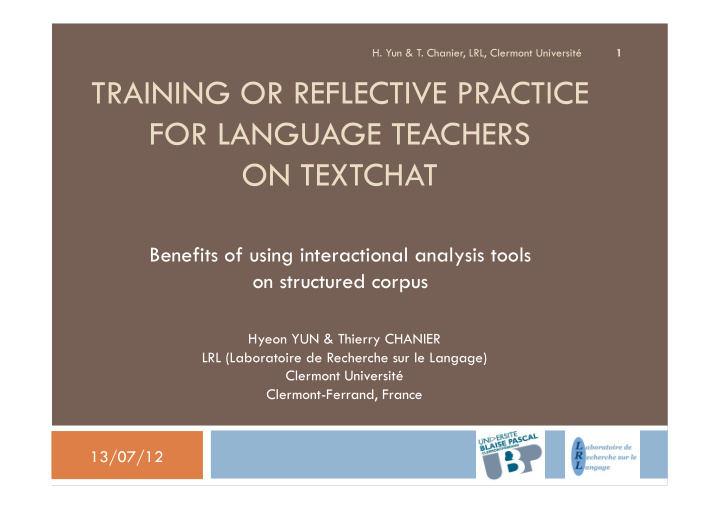



H. Yun & T. Chanier, LRL, Clermont Université 1 TRAINING OR REFLECTIVE PRACTICE FOR LANGUAGE TEACHERS ON TEXTCHAT Benefits of using interactional analysis tools on structured corpus Hyeon YUN & Thierry CHANIER LRL (Laboratoire de Recherche sur le Langage) Clermont Université Clermont-Ferrand, France 13/07/12
Objective(s) of this study 2 To show how trace analysis applied to interactional features in a learning and teaching textchat corpus may help foreign language teachers reflect on their pedagogical practices. H. Yun & T. Chanier, LRL, Clermont Université 13/07/12
Concept of Reflection-in-action & Reflection-on-action (Schön, 1984) 3 We reflect on action, thinking back on what we have done in order to discover how our knowing-in-action may have contributed to an unexpected outcome (Schön, 1983). Reflection is an important human activity in which people recapture their experience, think about it, mull it over and evaluate it. It is this working with experience that is important in learning (Boud et al ., 1985) H. Yun & T. Chanier, LRL, Clermont Université 13/07/12
Reflective practice – Reflective analysis – CSCL 4 CSCL: Computer Supported Collaborative learning Reflective analysis is key to collaborative learning to improve the practice of teachers (Laferrière, Murphy & Campos, 2005). H. Yun & T. Chanier, LRL, Clermont Université 13/07/12
TATIANA (Trace Analysis Tool for Interaction ANAlysts) 5 Analysis tool for interaction analysts. Designed by researchers from the CSCL (Computer Supported Collaborative learning) community. To analyse interactions that are mediated by technology and to be able to visualise and analyse combinations of log data and videos, transcriptions and so on. H. Yun & T. Chanier, LRL, Clermont Université 13/07/12
Textchat: synchronous interaction 6 Students interact between peers rather than interacting mainly with the teacher (Chun, 1994; Kern, 1995). The linguistic values is notable in the field of second language acquisition (Tudini, 2003; Jepson, 2005). There is a practical and interesting bridge between written and spoken skills for foreign language learners thanks to rigorously designed pedagogical activities in a specific learning context (Yun, 2009). H. Yun & T. Chanier, LRL, Clermont Université 13/07/12
The FAVI project 7 FAVI: Français Académique Virtuel International Objective To develop learners' linguistic and communication skills in French in an academic context through online activities. Audience Foreign students of various nationalities in postgraduates courses at the Université Sorbonne-Nouvelle and Université Paris Dauphine in France. Advanced and pre-advanced learners of French. Invited researchers, postdoctoral students and students in thesis. H. Yun & T. Chanier, LRL, Clermont Université 13/07/12
Textchat experiments in the FAVI project 8 Experiment 1 (preliminary experiment, 2005-2006) To observe how the students use the synchronous text-based communication tool. Free conversation between students. Experiment 2 (second experiment, 2007-2008) To let use linguistic registers suitable for academic discours. Chat logs assembled as a simple set of ASCII texts. Research publications from this set of data Problematic elements: Scientific validity General applicability of this work. H. Yun & T. Chanier, LRL, Clermont Université 13/07/12
Mulce format 9 Mulce = Multimodal Language Corpus Exchange H. Yun & T. Chanier, LRL, Clermont Université 13/07/12
LETEC (LEarning & TEaching Corpus, Chanier & Ciekanski, 2010; Reffay & Betbeder; 2009) 10 H. Yun & T. Chanier, LRL, Clermont Université 13/07/12
From FAVI textchat transcription to FAVI TATIANA format 11 1. FAVI as a simple set of ASCII texts H. Yun & T. Chanier, LRL, Clermont Université 13/07/12
From FAVI textchat transcription to FAVI TATIANA format 2. LETEC FAVI (XML) H. Yun & T. Chanier, LRL, Clermont Université 13/07/12 12
From FAVI textchat transcription to FAVI TATIANA format 3. TATIANA format 13 H. Yun & T. Chanier, LRL, Clermont Université 13/07/12
From FAVI textchat transcription to FAVI TATIANA format 4. Visualizing the tagged corpus by TATIANA 14 H. Yun & T. Chanier, LRL, Clermont Université 13/07/12
Coverage of LETEC FAVI 15 Experiment Nb de sessions Nb of tokens Nb of turns Faviep 9 24515 3223 Favie2 25 53090 4330 Total 34 77605 7553 H. Yun & T. Chanier, LRL, Clermont Université 13/07/12
16 General coverage for Faviep General coverage for Favie2 H. Yun & T. Chanier, LRL, Clermont Université 13/07/12
Categorization for analyses by TATIANA CMDA (computer mediated discourse analysis) approach. "CMDA as an approach to researching online behaviour provides a methodological toolkit and a set of theoretical lenses through which to make observations and interpret the results of empirical analysis" (Herring, 2004: 341). 17 H. Yun & T. Chanier, LRL, Clermont Université 13/07/12
Aspects of turn-taking between tutors and learners as shown by TATIANA 18 H. Yun & T. Chanier, LRL, Clermont Université 13/07/12
Categorization of a side sequence *a sequence in parallel with the principal conversation in order to treat a (linguistic or communicational) problem during the interaction and the problems of intercomprehension between actors (Jefferson, 1974; Bange, 1992). 19 H. Yun & T. Chanier, LRL, Clermont Université 13/07/12
Visualizing a side sequence by TATIANA 20 H. Yun & T. Chanier, LRL, Clermont Université 13/07/12
Visualizing an interaction scheme in progress (dialogue and trialogue in parallel) 21 H. Yun & T. Chanier, LRL, Clermont Université 13/07/12
Conclusions: Reflective functions of LETEC FAVI 22 Retrospection on how interactions were constructed and how linguistic or communicational obstacles were solved in context + Visualizing and analysing the context To reflect on how they develop activities and pedagogical scenarios which use the textchat communication tool. To improve their professional development through the reflective practice and the reflective thinking they desire in textchat activities they carry out and then analyse. H. Yun & T. Chanier, LRL, Clermont Université 13/07/12
Thank you for your attention! 23 H. Yun & T. Chanier, LRL, Clermont Université 13/07/12
Recommend
More recommend